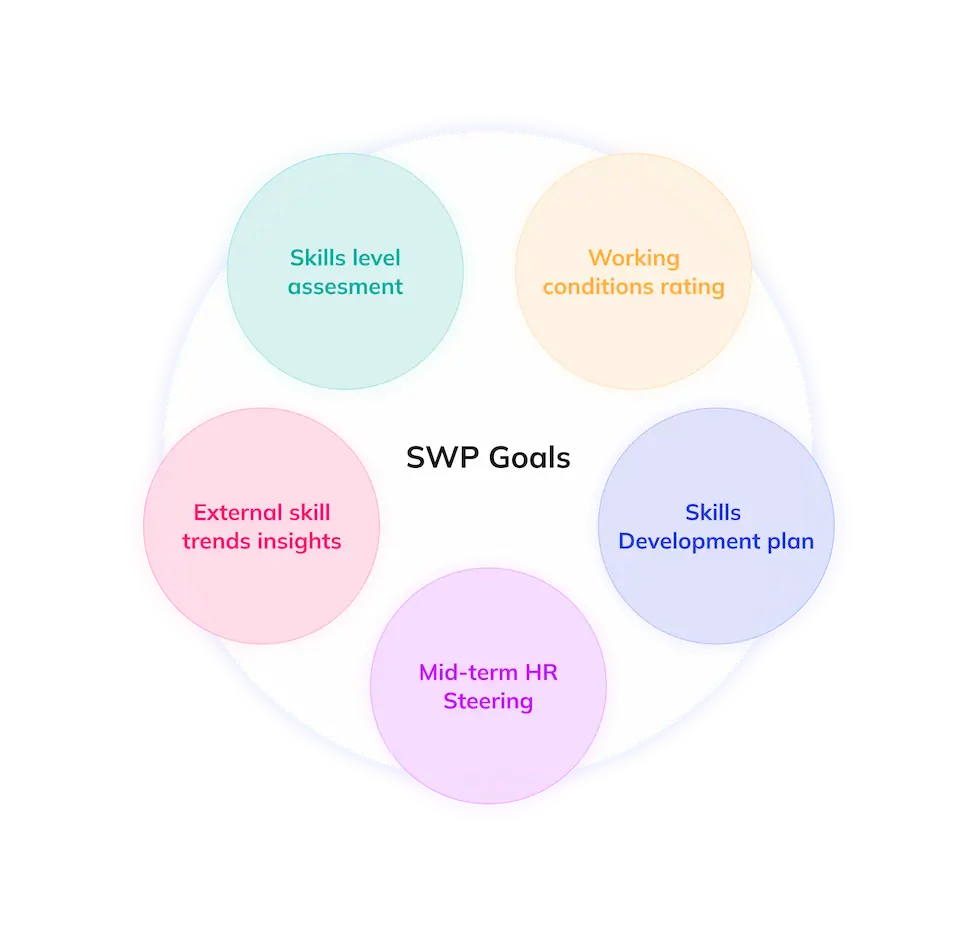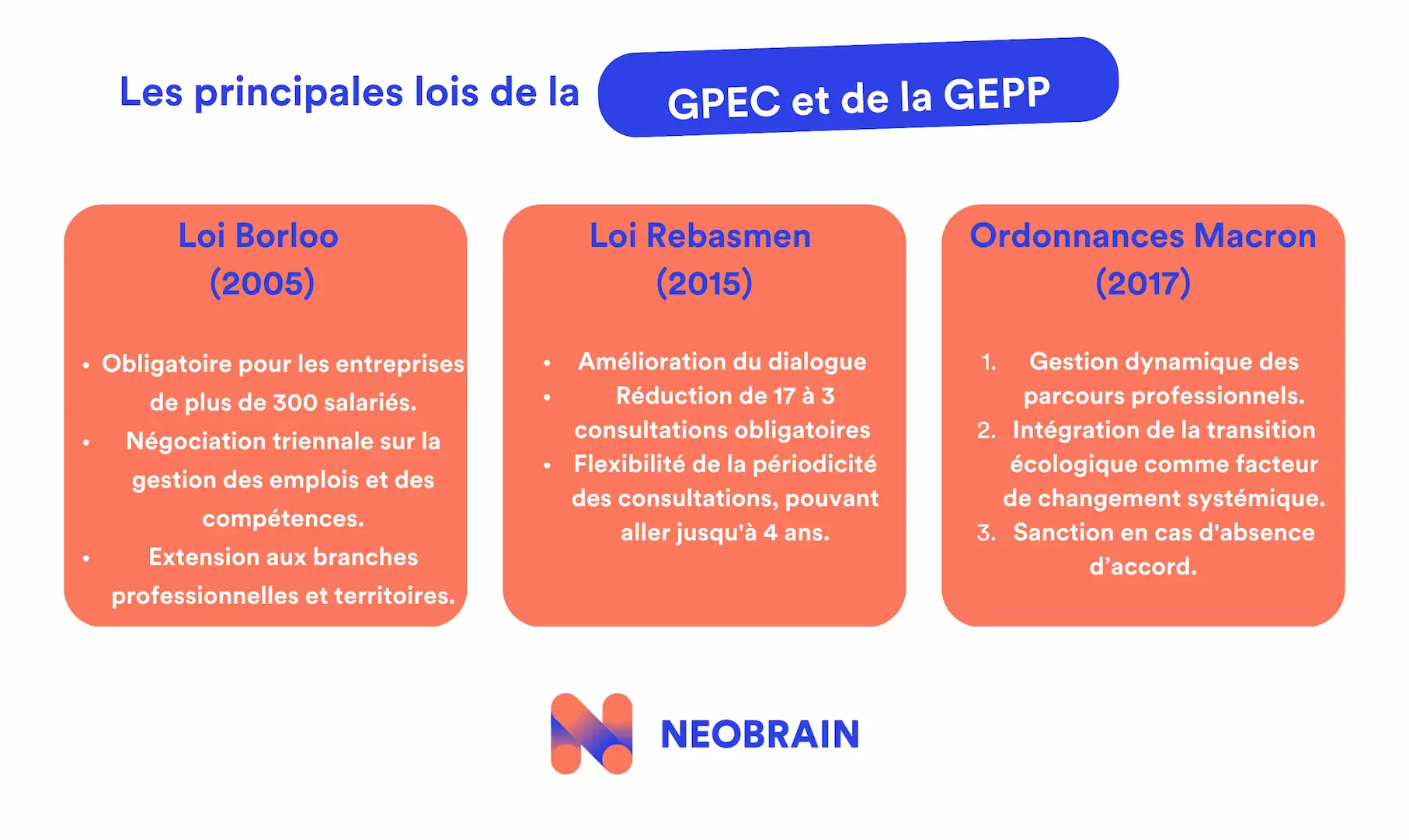Build and animate your Strategic Workforce Planning
Gestion Prévisionnelle des Emplois et des skills is the legislative framework for adapting skills employees to the company’s challenges. Gathering together all the factors of change, planning the employability of employees with the support of staff representatives, is an exercise that requires a robust methodology.

- Building a talent management policy
- From the Strategic Workforce Planning to Jobs & Skills Management : a response to new HR challenges
- The benefits sought through Strategic Workforce Planning
- Neobrain's support for your Strategic Workforce Planning in 3 points:
- Strategic Workforce Planning as an extension of the Strategic Workforce Planning
- FAQ
- You may also like
Building a talent management policy
Employers are obliged to help employees adapt to their workstations and maintain their ability to hold down a job. He therefore defines the target organization and the most appropriate means of support(Article L. 6321-1 of the French Labor Code). This legal framework was accompanied by a number of legislative texts, which gave rise to the Strategic Workforce Planning and Jobs & Skills Management.
The Borloo law (2005)
- Mandatory for companies with more than 300 employees.
- Three-yearly negotiations involving employers, union representatives and works council.
- Extension to professional branches and territories for coordinated management of skills.
The Rebsamen law (2015)
- Improved social dialogue with a reduction in the number of mandatory consultations of the CSE from 17 to 3.
- Consultations on strategic orientations, the economic and financial situation, and social policy.
- Flexible consultation schedule, with a maximum frequency of three years, improving human resources management.
From the Strategic Workforce Planning to Jobs & Skills Management : a response to new HR challenges
Gestion des Emplois et Parcours Professionnels has replaced Gestion Prévisionnelle des Emplois et des skills since 2017 through the Macron ordinances.
Macron Ordinances (2017)
- Replacement of the Strategic Workforce Planning by Jobs & Skills Management, focusing on dynamic career management.
- Integrating ecological transition as a factor of systemic change.
- Three-year obligation to negotiate, flexible up to 4 years, with penalties for failure to reach agreement.
What new prerogatives does this evolution entail for the HR function?
The Jobs & Skills Management adds 3 positive notions to HR teams’ understanding of resource planning:
- Prevention of obsolescence of skills, guarantee of employability.
- Empowering employees to build their own career paths.
- Transparency on the trades and skills priorities for business performance.
In fact, the vast majority of HR decision-makers continue to refer to this exercise as “Strategic Workforce Planning”. However, there are real differences, and we retrace the history and differences between these 2 terminologies on our “From Strategic Workforce Planning to Jobs & Skills Management” page.
The benefits sought through Strategic Workforce Planning
A simple and pragmatic tool to support your HR strategy cannot be decreed, it must be built with all stakeholders. Indeed, the objective of a Jobs & Skills Management approach is to be virtuous for the whole company. In this context, the preparation, the diagnosis and the negotiations are the first pivotal steps. Discover how to define the basis of your negotiations.
The main points of attention that we highlight are:
- Ensure alignment of your job and career management solutionwith your HR culture and practices;
- Converge annual interviews, development plans, internal mobility plans and talent reviews in a single HR management tool;
- To offer an ergonomic and intuitive solution that mobilizes all HR stakeholders to reach a good agreement Jobs & Skills Management.
Mobilizing stakeholders through the Strategic Workforce Planning
Detecting and making HR data reliable requires the involvement of employees and managers.
What are the key activities for empowering every HR player?
The 3 key activities are:
- The mobilization of employees asstes calls for the consideration of each of the skills and the expression of the motivations;
- The identification of skills offers visibility on the bridges between the different professions to increase your opportunities for internal mobility;
- Continuous updating of your talent management platform becomes a reality through continuous enrichment of the skills of tomorrow.
The investment of the HR stakeholders is part of many challenges summarized in our page“the stakes of the Strategic Workforce Planning“.
An illustration of a Strategic Workforce Planning project with Natixis :
Description of the challenge: Improvethe match between skills and internal offers for the 2,500 employees in France.
Solutions and results :
- Detection of undisclosed skills thanks to AI and employee involvement: 50,000 skills detected.
- Creation of a common language to ensure consistency between skills and job offers: 85% take-up in 2 weeks.
- Suggesting the best career paths to increase internal mobility: 50% progression in 6 months.
Here’s what Cristel Guillain, Head of Transformation & Talent at Natixis, has to say.
Strengthen Skills adaptation
Strategic Workforce Planning and skills management are intimately linked, as the result is an alignment of know-how and strategy. This ambition is translated operationally by the creation of a skills management softwarepackage that brings together your HR data to produce unique insights. HR teams need to be guided in a sustainable skills management strategy and to better anticipate career management.
What are the components of a high-performance Strategic Workforce Planning solution?
- Automate the creation of job repositories and skills to focus on developing your talents’ potential and better balance external and internal recruitment;
- Make the right HR decisions using a tool that Strategic Workforce Planning that provides visibility on individual and collective skills gaps;
- Establish a step-by-step approach in a methodology that combines the initiative of management on key skills and the pragmatism of managers and business experts.
Here are the benefits of the technology dimension of a software from Strategic Workforce Planning :
- Don’t leave any skill to chance, detect and value each current skill to enrich your human capital;
- Respond to business transformations with a head start: the risks of losing skills and their obsolescence are visible on a centralized dashboard.
- Use emerging business trends and skills to suggest training, plan your resources and implement succession plans.
This process requires a certain amount of preparation, which we explain in our page “5 best practices when choosing your Strategic Workforce Planning solution“.
Illustration of the benefits of AI in an HRIS project with Sage :
Description of the challenge:Disposing ofa snapshot of skills to support employees in the transformation of their professions.
Solutions provided :
- Integration of skills of target trades with trained artificial intelligence;
- Identifying individual and collective development needs;
- Adapting our training policy to support the transformation of our businesses.
AI is one of the levers that can be used to build a forward-looking approach that is both lasting and motivating, and we develop all these mechanisms in the “gpec tools” section.
Neobrain’s support for your Strategic Workforce Planning in 3 points:
- To help you carry out a global HR diagnosis of your company’s jobs, employment and skills ;
- To offer you the anticipation tool that reconciles the company’s performance and the employees’ aspirations;
- To bring you the collaborative solution of building the future of the 3 actors of the organization:
- Employees seize internal opportunities and develop the skills that make sense for their career direction,
- Managers identify the best levers for supporting talent and allocate resources to strategic projects,
- The HR function involves all stakeholders in strategic, measurable organizational planning.
The Neobrain software suite provides you with the complete and intelligent foundation for the continuous transformation of your organization. Each of our modules can be implemented independently to take you one step further.
Strategic Workforce Planning as an extension of the Strategic Workforce Planning
Aligning your resources over the next 2-3 years with your HR strategy means :
- Be aware of available resources and skills emerging needs before you start planning. The use of AI increases this HR agility;
- Modeling scenarios from your HR data allows you to develop pragmatic resource planning with all stakeholders;
- Plan and reduce the uncertainty of your skills, businesses and workforce in line with your strategic and financial objectives.
Today, it’s a question of going further than what Jobs & Skills Management offers, by associating business needs more closely with HR planning. Find out more about how the SWP model works, the data that feeds it, the differences with Jobs & Skills Management, and concrete examples on our Page dedicated to “Strategic Workforce Planning“.
FAQ
How to go from Strategic Workforce Planning to Jobs & Skills Management ?
GPEC acknowledges the accelerated transformation of jobs, particularly under the influence of digital and ecological changes. Therefore, it is crucial to strengthen the monitoring of emerging skills and enrich the range of opportunities for employee adaptation, such as professional development and internal mobility based on individual aspirations. This is why the integration of a unified software capable of leveraging all competency data becomes essential.
What are the ingredients to anchor Jobs & Skills Management in the company?
GPEC is inseparable from talent management policy as it encompasses key elements of fostering engagement. Prior to GPEC, the company should invest in a thoughtful process of understanding and integrating the impact of various transitions on its jobs. After GPEC, translating these elements into concrete opportunities and making them visible contributes to the successful orchestration of the process.
How to anticipate major changes in the business?
Maintaining constant monitoring of market trends and technological advancements can be done partially through industry experts, as well as through individual interviews with employees. Our experience highlights two success factors:
- Consolidate all this information in one place
- Supplement this information with external sources of data.
In this regard, Neobrain provides the level of risk of job obsolescence and emerging sector-specific skills to assist HR teams in guiding their policies.
How to involve managers in the Jobs & Skills Management process?
The company expects managers to play a role focused on the employability of their teams: GPEC is one of the pillars for ensuring that skills are aligned with the rapid changes managers observe in their daily work. We recommend involving them in defining the key competencies of the company and identifying within their teams those elements that could be good successors. Additionally, some clients encourage managers to actively participate in GPEC by rewarding talent management performance. This can include financial incentives or public recognition based on achieving the objectives outlined in the GPE
Do you still have questions ?
Please feel free to contact us for more information 😃















